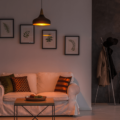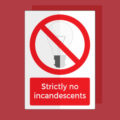There is a lot to think about when it comes to buying LED lighting. As a result, we get a lot of questions about LED light bulbs, and how they’re different from other types of light bulb.
Below are ten of the ten most common LED lighting questions, and our answers for them. If you need any further help with any of this, have a look at our extensive library of guides and advice articles.
How are LED light bulbs different from other types of light bulbs?
LED light bulbs are the latest technology in the lighting world. They are more energy-efficient than other types of light bulbs, have longer lifespans, and allow you to be much more creative with your lighting design.
The humble LED has been around for a century, but for much of this time, it has only been used as an indicator light in electrical equipment (such as the power light on televisions). It took a Nobel Prize-winning effort to adapt the LED to be a viable lighting technology.
Once this was achieved, manufacturers could mount LED chips onto light bulbs as an alternative to traditional lighting. Where incandescent light bulbs heat a filament to generate light, LED light bulbs are illuminated by the movement of electrons in a semiconductor material. This provides many benefits, including longer lifespans, increased energy efficiency, and greater adaptability.Can I use LED lights outdoors?
Yes, there are many different types of LED lights that are suitable for use outdoors.
The most important thing to remember when buying LED lighting for use outdoors is that they should have a suitable Ingress Protection (IP) rating. This rating tells you how protected the light is from the ingress of water and solid objects.
Outdoor lighting should have an IP rating of 44 or greater, as this will protect it from solid objects up to 1mm in size, and from splashing water. If the lights are situated in a position that is very exposed to the elements, they should have an IP rating of 65 or greater.
For more information and why they are so important, read our guide to IP ratings.Are smart lights the same as LED lights?
In short, all smart lights are LED but not all LED lights are smart.
Smart lights are a subcategory of LED lights that allow you to connect your lighting network to your home Wi-Fi. By doing so, you unlock a whole host of features, such as the ability to adjust your lighting with your smartphone, set schedules and change the colour and/or colour temperature in an instant.
LED light bulbs can only be used in smart lighting networks if they have been specifically created for the purpose. Smart light bulbs are quite clearly marketed as such and are difficult to confuse with standard LED light bulbs.
Read more about LED smart lighting.Do LED light bulbs get hot?
LED light bulbs do get warm, but nowhere near as hot as traditional incandescent light bulbs. Incandescent light bulbs generate light by heating a delicate filament to very high temperatures. As a result, the glass envelope of these light bulbs gets very hot.
LED light bulbs work differently, and do not use heat to generate light, so they do not get nearly as hot. Like all electrical components, though, they do still generate a little heat, but not to the point where they are dangerous to touch. LED light bulbs will often have a heat sink built into them to divert any heat away from the delicate electrical components.What are lumens?
Lumens (lm) are a measure of how much visible light a lamp or other light source emits, and they are the easiest way to determine how bright a light bulb is.
It used to be the case that wattage was the best indicator of a light bulb’s brightness. The rule was that the more power (watts) that goes in, the more light that will come out.
With the development of various energy-saving light bulbs, including LED lighting, this is no longer valid. As they do not lose a lot of their energy through heat (as incandescent light bulbs do) they are much more efficient and need much less power to generate the same amount of light. A 5W LED light bulb, for example, can be just as bright as a 50W incandescent light bulb.
This is where lumens come in. As lumens are a measure of a light bulb’s output, rather than its input (as is the case with its wattage), it provides a more reliable way of measuring its brightness, and it also means you can compare the brightness of different types of light bulbs.
The higher the lumens count, the brighter the light bulb. Standard household light bulbs can vary in brightness, but typically have a lumens count anywhere between 300-800lm. On the other hand, certain industrial-use light bulbs, such as High-Intensity Discharge (HID) light bulbs, can have lumens ratings in the tens or hundreds of thousands.Do LED light bulbs really save money?
Although their price is constantly falling, LED light bulbs still cost more per unit than other types of light bulb.
However, in the long run, LED light bulbs definitely will save money compared to incandescent light bulbs, for two reasons.
Firstly, the energy efficiency of LED light bulbs means that they use up to 90% less energy than incandescent light bulbs to achieve the same level of brightness. This can bring energy bills down and save money in the long-term.
Secondly, LED light bulbs now have an incredibly long lifespan compared to other types of lighting technologies. Where an incandescent light bulb might last for 1,000 hours, an equivalent LED light bulb can last in excess of 20,000 hours. This means that for every one LED light bulb you buy, you would need to buy 20 incandescent light bulbs to cover the same period. The unit price of LED light bulbs no longer seems so expensive.
Have a look at our LED savings infographic to learn more.Will LED light bulbs fit my current lamps?
The vast majority of LED light bulbs are built to retrofit to existing lamps, meaning that they will fit in compatible fixtures. An LED light bulb with a standard B22d bayonet cap (BC), for example, will fit straight into a standard bayonet cap lamp.
You can read our article on available cap types here.Are LED light bulbs bad for you?
LED lighting emits greater levels of blue light than other forms of lighting, and some say this can have detrimental health effects. Research on the subject has been limited, however, so the exact effects (if any) aren’t really understood.
A recent study published by the European Commission concluded that for an LED light to have an adverse effect on your health, exposure levels would need to be ‘greater than those likely to be achieved with LED lighting systems in practice,’ meaning that the effect from a normal household and commercial use is negligible.
Blue light has been proven to affect your sleep, however. It suppresses the production of the sleep-regulating hormone melatonin, which can cause fatigue and restlessness, which can lead to further health issues.
Smartphone displays and cool white LED lights that give off a lot of blue light should not be used right before bedtime, as this can stop you from sleeping. Instead, use warm white light bulbs, which emit a lot less blue light, and if you do use your phone in bed, turn on its blue light filter if it has one.Are LED light bulbs compatible with dimmer switches?
Yes, and no, as LED technology differs greatly from traditional incandescent light bulbs, the componentry within the LED light bulb comes in dimmable and non-dimmable varieties, LED dimmable light bulbs are compatible with certain types of dimmer switch. There are two types of dimmer switch: a leading-edge and trailing edge. Most LED light bulbs are manufactured to be compatible with trailing edge dimmer switches, however, it’s always best to check the manufacturer’s specifications before you purchase to be sure.
Determining how many light bulbs you can use with one dimmer switch takes a little calculation. You can learn more by reading our dimmer switch compatibility guide.Do LED light bulbs flicker?
When operating correctly, LED lights should not have any visible flicker.
If they are installed with an incompatible dimmer switch, LED light bulbs may flicker unpleasantly. If this happens, you should check the compatibility of the light bulb with your dimmer and replace the light bulb and/or the switch. See the LED dimming guide above for more information.




